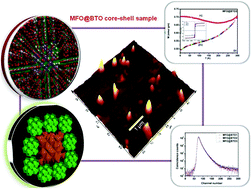Magnetic performance and defect characterization studies of core–shell architectured MgFe2O4@BaTiO3 multiferroic nanostructures
Abstract
Multiferroics that permit manipulation of the magnetization vector exclusively by electric fields have spawned extensive interest for memory and logic device applications. In line with this understanding, we herein report the encapsulation of non-ferroelectric magnesium ferrite (MgFe2O4) nanoparticles in a ferroelectric shell of BaTiO3 to produce a system with engineered dielectric, magnetic, magneto-electric and ferroelectric properties. The interface effect on the strain transfer was observed to strongly influence the magneto-electric coupling and the electric and magnetic properties of the system. The model polyhedral image of MgFe2O4@BaTiO3 has helped to get an insight into the core–shell structure. The multiferroicity induced by the excellent coupling between the ferroelectric and magnetostrictive phases at the core–shell interface unlocks wide prospects for device downscaling and information storage applications. The influence of magnetostrictive stress on the magneto-electric coupling effects and domain dynamics was further studied using transmission electron microscopy (TEM) and atomic force microscopy images. Interestingly, the realization of a superparamagnetic multiferroic system has been a breakthrough and facilitates ultra high density magnetic data storage technologies. Evidence for spontaneous polarization and the ferroelectric trait exhibited by the multiferroic samples was revealed from the P–E hysteresis loop. The investigation of defect evolution in the system was carried out using positron annihilation lifetime spectroscopy (PALS) and coincidence Doppler broadening spectroscopy (CDBS) of annihilation radiation and the studies revealed thermal diffusion of positrons into the interfacial regions within the core–shell structure and the “formation and pick-off annihilation of orthopositronium atoms”. It is concluded that interface engineering is a strong means for manipulation of the magnetic, dielectric and magneto-electric properties in multiferroic heterostructures for high density electrical energy and magnetic data storage.



 Please wait while we load your content...
Please wait while we load your content...